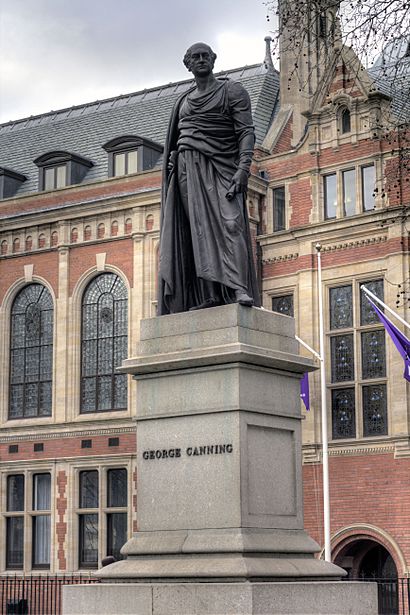Statue of George Canning, Parliament Square facts for kids
Quick facts for kids Statue of George Canning |
|
|---|---|

The statue in 2015
|
|
| Artist | Richard Westmacott |
| Year | 1832 |
| Medium | Bronze sculpture |
| 51°30′04″N 0°07′40″W / 51.50100°N 0.12775°W | |
The statue of George Canning is a famous sculpture found in Parliament Square in Westminster, London. It was created in 1832 by Sir Richard Westmacott, a well-known artist of that time. This statue honors George Canning, who was a British Prime Minister in 1827.
Contents
About the Statue of George Canning
This section describes what the statue looks like and its important features.
What the Statue Looks Like
The statue is made of bronze and is very tall, standing about 3.56 meters (11 feet 8 inches) high. This means it is "larger than life size," making George Canning look even more impressive.
The sculpture shows George Canning wearing a long robe and a cloak. He holds a scroll in his left hand. This style is similar to old Roman statues of important speakers, known as orators. Even though his top half looks ancient, his legs are covered with modern trousers, and he has laced shoes.
The statue stands on a tall stone base, called a plinth, which is about 4.4 meters (14 feet 5 inches) high. On the front of this base, you can clearly read the name "GEORGE CANNING."
History of the Statue
The statue was first put up near St Margaret's, Westminster, close to Old Palace Yard. It was officially revealed to the public on May 2, 1832. This happened five years after George Canning passed away in August 1827, when he was 57 years old and still serving as Prime Minister.
Many people thought the statue looked a lot like George Canning. The artist, Richard Westmacott, based his work on a smaller sculpture of Canning's head and shoulders, called a bust. This bust was made by another famous artist, Francis Chantrey, for Canning's memorial inside Westminster Abbey.
Moving to Parliament Square
In 1867, the statue was moved to its current home in Parliament Square. It was the very first statue to be placed in the square as it was being designed and built.
Today, the statue stands outside a building at 12 Great George Street. This building is home to the Royal Institution of Chartered Surveyors. The area around the statue is now even known as Canning Green. In 1970, the statue was given a special status as a Grade II listed building. This means it is an important historical structure that needs to be protected.
Images for kids


